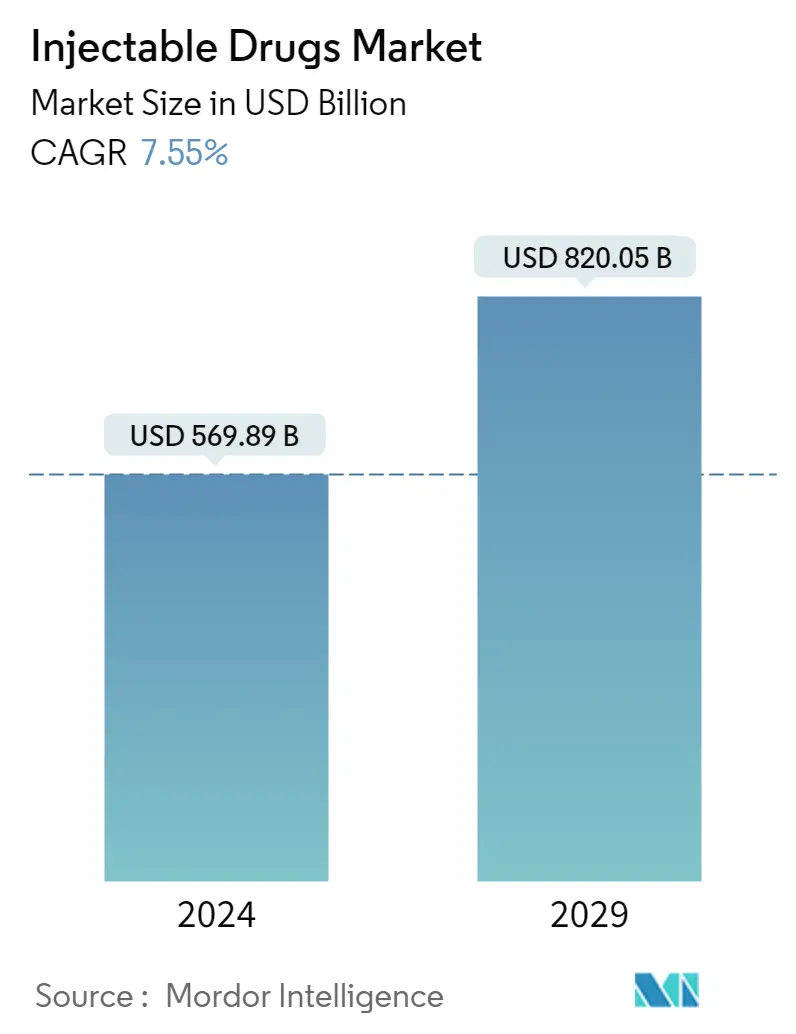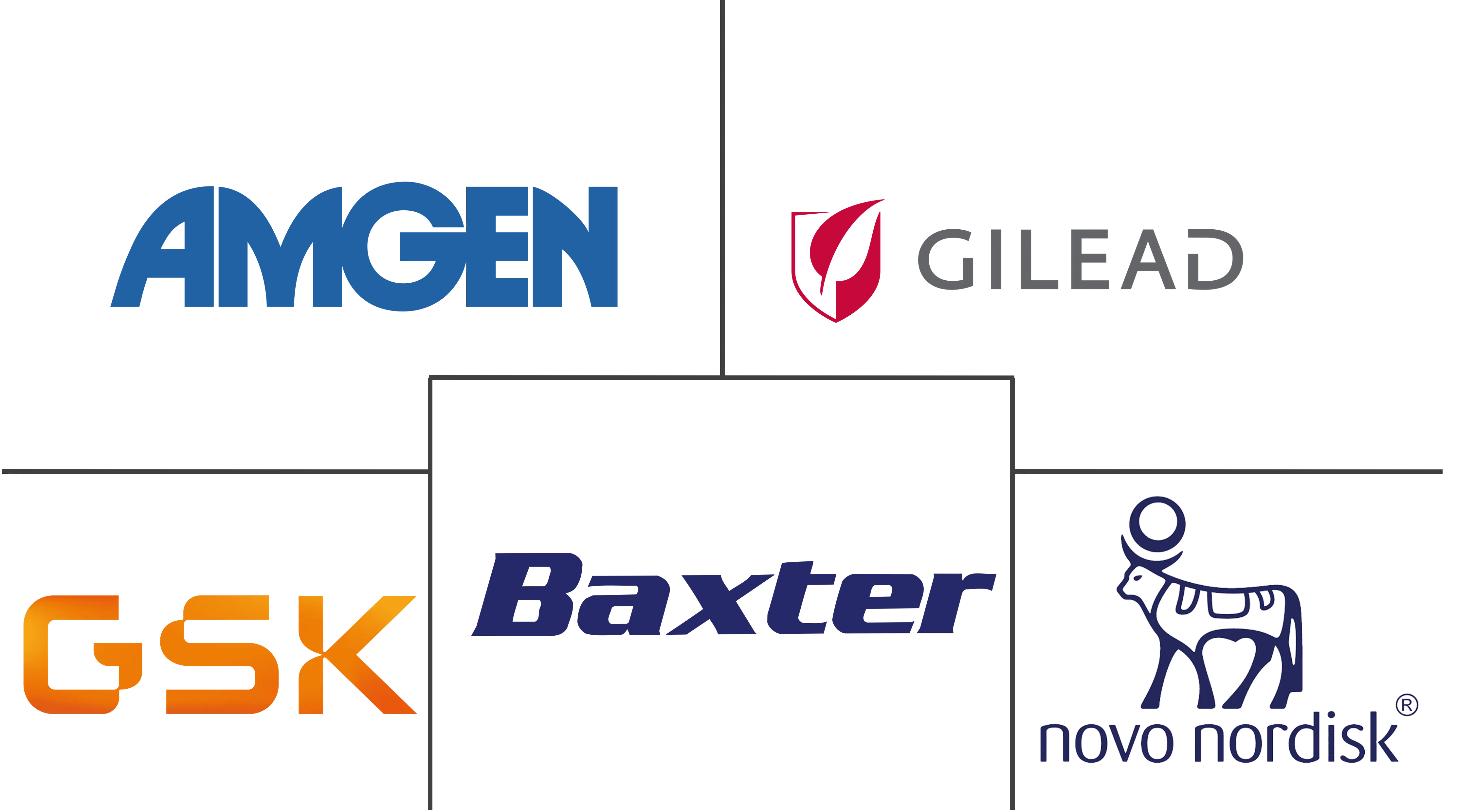Market Size of Injectable Drugs Industry

| Study Period | 2019 - 2029 |
| Market Size (2024) | USD 569.89 Billion |
| Market Size (2029) | USD 820.05 Billion |
| CAGR (2024 - 2029) | 7.55 % |
| Fastest Growing Market | Asia-Pacific |
| Largest Market | North America |
Major Players
*Disclaimer: Major Players sorted in no particular order |
Need a report that reflects how COVID-19 has impacted this market and its growth?
Injectable Drugs Market Analysis
The Injectable Drugs Market size is estimated at USD 569.89 billion in 2024, and is expected to reach USD 820.05 billion by 2029, growing at a CAGR of 7.55% during the forecast period (2024-2029).
COVID-19 impacted the growth of the market studied. During the pandemic, companies were developing drugs and seeking collaborations and approvals to develop a vaccine for COVID-19. These vaccines were majorly given in the injectable form, driving the market growth. For instance, in May 2020, AstraZeneca received more than USD 1 billion in funding from the US Health Department's Biomedical Advanced Research and Development Authority (BARDA) for the development, production, and delivery of the University of Oxford's COVID-19 vaccine. Moreover, with the released COVID-19 restrictions and resumed company activities, the market is expected to grow over the forecast period.
The factors such as rising R&D focus on developing biotechnology-engineered anti-cancer drugs, rapid growth in the usage of pre-filled syringes for biologics, and increased outsourcing activities across the value chains expected to raise the supply of injectable drugs are boosting the market growth.
The rising prevalence of chronic diseases such as cancer, diabetes, cardiovascular diseases, and others is the key factor driving the market growth. For instance, from an article published in BioMed Central Journal in May 2022, it has been observed that 26.7 million people in India were suffering from cancer and this number is projected to increase to 29.8 million by 2025. Also, according to 2022 statistics published by the IDF, about 3.9 million people were living with diabetes in France, and this number is projected to reach 4.1 million by 2030 and 4.2 million by 2045. Thus, the high burden of chronic diseases among the population is anticipated to increase the demand for effective and safe injectable drugs hence propelling the market growth.
Additionally, a report published by the UK Health Security Agency in December 2021, stated that in 2020, an estimated 97,740 people were living with HIV in England and an estimated 4,660 in 2020 were unaware of their infection, indicating the demand for injectable HIV drugs and formulations, which are anticipated to augment the market growth over the forecast period. Also, from an article published in the International Journal for Equity in Health in August 2021, it was observed that 75.8% of the elderly population aged 60 years and above were troubled by one or more chronic diseases such as heart disease, cancer, chronic lung diseases, and others.
Furthermore, the rising focus of companies on developing injectable drugs for new therapeutic classes is expected to increase their adoption by physicians and patients and their availability in the market, which in turn is anticipated to fuel market growth. For instance, in September 2022, the USFDA accepted the Biologics License Application (BLA) and granted Priority Review designation to Chiesi Global Rare Diseases, velmanase alfa, an enzyme replacement therapy, for the treatment of alpha-mannosidosis. Also, in December 2021, the USFDA approved Apretude (Cabotegravir extended-release injectable suspension) for adolescents weighing at least 35 kg for pre-exposure prophylaxis to reduce the risk of sexually acquired HIV.
Moreover, the rising development of bio-engineered anti-cancer drugs is also increasing the market growth. For instance, in April 2022, the China National Medical Products Administration (NMPA) approved BeiGene's tislelizumab to treat patients with locally advanced or metastatic oesophageal squamous cell carcinoma (ESCC), a type of oesophageal cancer. Also, in December 2021, the Center for Drug Evaluation (CDE) of China's National Medical Products Administration (NMPA) approved I-Mab's IND submission for the initiation of a phase 2 trial in China for enoblituzumab (also known as TJ271) in combination with pembrolizumab (Keytruda) in patients with solid tumors, including non-small cell lung cancer (NSCLC), urothelial carcinoma (UC), and other selected cancers.
However, the high expenses associated with inventory management and the availability of alternate drug delivery methanes are likely to hinder the market growth over the forecast period.
